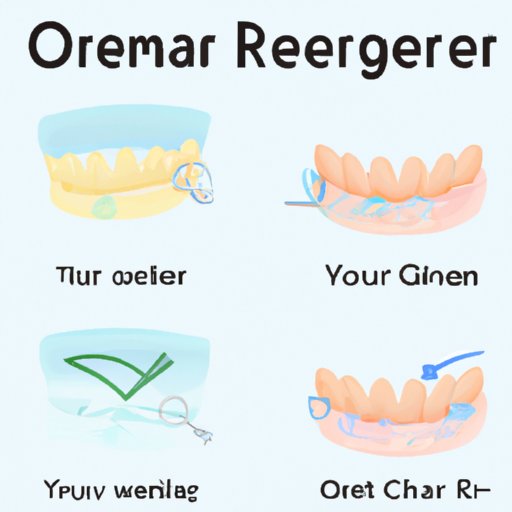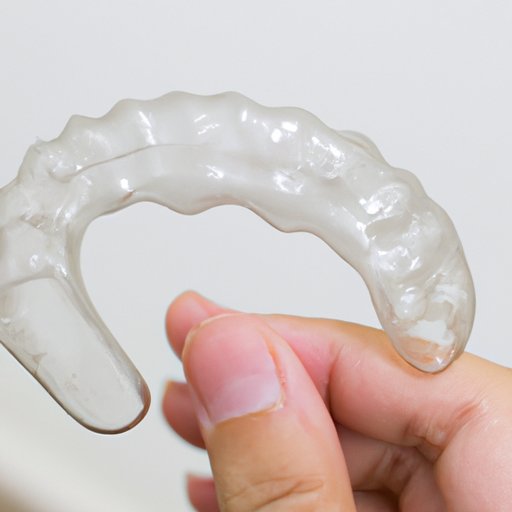I. Introduction
Retainers are an essential part of dental treatment, as they help maintain proper tooth alignment and ensure optimal oral health. But like any other dental appliance, retainers can also get dirty and become a breeding ground for bacteria if not cleaned properly. Failure to keep your retainer clean can lead to bad breath, gum disease, cavities, and other dental issues.
To ensure that your retainer remains clean and healthy, it is essential to develop a cleaning routine that works for you. In this article, we will explore six easy and effective ways to keep your retainer fresh and clean.
II. 6 Easy and Effective Ways to Clean Your Retainer at Home
Cleaning your retainer regularly helps eliminate bacteria that can harbor on it. Here are six easy and effective ways to clean your retainer at home.
Method 1: Brushing with a Soft-Bristled Toothbrush
Brushing your retainer with a soft-bristled toothbrush is one of the most effective ways to remove plaque and bacteria buildup. Using lukewarm water and a gentle soap, gently scrub your retainer to remove any debris or bacteria.
Method 2: Soaking in Vinegar
Vinegar is a powerful cleaning agent that can help remove bacteria and plaque. Create a mixture of equal parts of lukewarm water and white vinegar and soak your retainer in the solution for at least 15 minutes. Rinse with water and allow it to air dry.
Method 3: Using Retainer Cleaning Tablets
Retainer cleaning tablets are an effective and convenient way to clean your retainer. Simply fill a cup with lukewarm water, drop in the tablet, and soak your retainer for the recommended time. Rinse thoroughly with water.
Method 4: Rinsing with Mouthwash
Mouthwash is an excellent way to freshen your breath and eliminate bacteria. Rinse your retainer with mouthwash and let it sit for a few minutes before rinsing with water and allowing it to air dry.
Method 5: Using Baking Soda and Water
Baking soda is a mild abrasive that can help remove bacteria buildup and stains from your retainer. Create a paste by mixing baking soda and water and apply the mixture to your retainer. Gently scrub and rinse thoroughly with water.
Method 6: Cleaning with Hydrogen Peroxide
Hydrogen peroxide is a powerful disinfectant that can help kill bacteria. Create a solution of equal parts hydrogen peroxide and lukewarm water. Submerge your retainer in the mixture for at least 30 minutes, then rinse thoroughly with water.
III. Say Goodbye to Bacteria: The Best Methods to Clean Your Retainer
Poor retention cleaning habits can lead to bacterial buildup on your retainer. Here are some of the best methods to clean your retainer and eliminate bacteria.
Method 1: Brushing with Antibacterial Soap
Antibacterial soap is specifically formulated to fight bacteria, making it an excellent way to clean your retainer. Apply a small amount of antibacterial soap to a soft-bristled toothbrush and gently scrub your retainer before rinsing thoroughly with water.
Method 2: Soaking in an Antimicrobial Solution
An antimicrobial solution is specially formulated to eliminate bacteria and viruses. Soak your retainer in an antimicrobial solution for at least 30 minutes, then rinse thoroughly with water.
Method 3: Using Retainer Cleaning Spray
Retainer cleaning sprays are an easy and convenient way to keep your retainer clean and free from bacteria. Simply spray your retainer with the solution and let it sit for the recommended time.

IV. Retainer Care 101: Top 6 Ways to Keep Your Retainer Fresh and Clean
Proper care and maintenance of your retainer are crucial to ensuring optimal oral health. Here are six of the top ways to keep your retainer fresh and clean.
Tip 1: Brushing the Retainer Daily
Brushing your retainer with a soft-bristled toothbrush and gentle soap daily removes bacteria that accumulate on the retainer.
Tip 2: Soaking the Retainer in Fresh Water
Soaking your retainer in fresh water helps to remove debris and bacteria. This should be done every time you remove your retainer.
Tip 3: Proper Storage Methods
When not in use, store your retainer in its appropriate case to prevent it from collecting bacteria and drying out.
Tip 4: Regular Dental Check-Ups
Your dentist can provide a professional cleaning for your retainer, as well as monitor your oral health and recommend appropriate retainer cleanings.
Tip 5: Handling with Care
Be gentle when removing or inserting your retainer so that you don’t damage it and reduce the risk of bacteria buildup
Tip 6: Avoiding Certain Foods and Drinks
Avoid hot drinks, soda, and sugary foods that can damage your retainer and cause bacteria buildup.
V. Just Keep it Clean: Simple Strategies to Clean a Retainer
Retainer cleaning should be a daily routine, reducing bacterial growth on the retainer. Here are a few simple strategies for cleaning your retainer.
Method 1: Using a Retainer Cleaning Brush
A dedicated retainer cleaning brush can help remove bacteria and plaque buildup, and it is a convenient tool for daily cleaning.
Method 2: Using Dish Soap and Water
Using dish soap and water works well against bacteria and plaque. Gently rub the retainer with a soft-bristled toothbrush and the soap and rinse well before soaking in plain water.
Method 3: Brushing with Toothpaste and Water
You can use toothpaste to clean your retainer. However, you should use fluoride-free toothpaste as fluoride can damage some types of retainers. Gently brush your retainer with toothpaste and rinse thoroughly with water.
VI. The Ultimate Guide to Cleaning Your Retainer: 6 Proven Techniques
Cleaning your retainer daily and weekly using one of the six above-mentioned methods can ensure a clean retainer and reduce the buildup of bacteria. Find a method that works best for you, as a cleaner retainer contributes to better dental health and hygiene.
VII. Protect Your Teeth Investment: 6 Ways to Properly Clean Your Retainer
Retainers, like braces, represent an investment in your dental health. It is essential that you take care of your retainer to ensure proper alignment of your teeth in the coming years. Here are six ways to properly clean your retainer.
Tip 1: Cleaning the Retainer Immediately After Removal
It is essential that you clean your retainer immediately after removing it from your mouth to prevent bacteria buildup.
Tip 2: Use Gentle Cleaners
Avoid using harsh cleansers that can damage the retainer and cause the buildup of bacteria. Use only gentle, retainer-specific cleaners or a mild soap and water.
Tip 3: Avoid Hot Water
Hot water can damage your retainer; thus, it’s essential to avoid hot water when cleaning your retainer.
Tip 4: Visit a Dental Professional When Necessary
Your dentist can provide you with professional retainer cleanings and check-ups to ensure optimal dental health.
Tip 5: Don’t Overdo It with Cleaning
Clean your retainer only once or twice a day to avoid damaging the retainer and to prevent over-cleaning as well.
Tip 6: Replace the Retainer as Needed
Your retainer gets worn over time, and it’s essential to replace the appliance when it’s worn or damaged to ensure optimal dental health.
VIII. Conclusion
Cleaning your retainer is an essential part of maintaining good oral hygiene. The bacteria buildup on the retainer can lead to bad breath, gum disease, cavities, and other dental issues if not cleaned properly.
We have gone through six easy and effective methods for cleaning your retainer, as well as the importance of developing a cleaning routine and proper care of your retainer.
We encourage you to try different methods to find what works best for you and to prioritize the care of your retainer to ensure optimal oral health. With the tips mentioned above, maintaining a fresh and clean retainer should be a breeze.
(Note: Is this article not meeting your expectations? Do you have knowledge or insights to share? Unlock new opportunities and expand your reach by joining our authors team. Click Registration to join us and share your expertise with our readers.)
